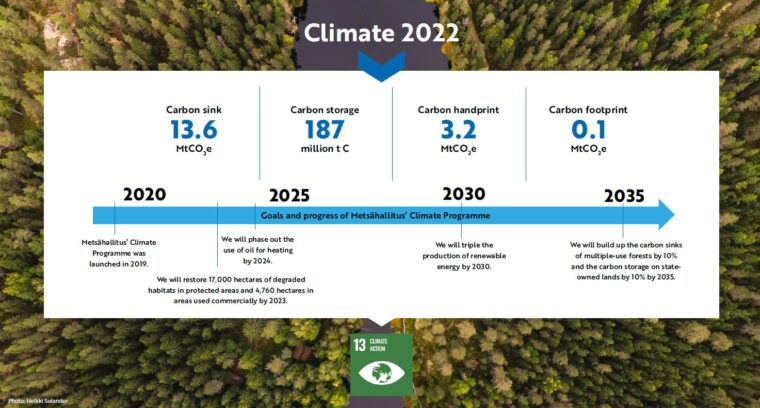Metsähallitus’ Climate Programme
Climate change and adaptation to it play a large part in Metsähallitus' strategy. Our Climate Programme promotes the attainment of Finland's climate targets and transition to a carbon-neutral society by 2035 through increasing carbon sinks, carbon storage and clean energy production as well as by cutting our emissions.
State-owned forests are a significant carbon sink and growing carbon storage
The baseline level of the Climate Programme data was calculated for 2018. The calculations are based on data produced by the 12th National Forest Inventory. The development of the carbon sink and carbon storage is assessed annually on the basis of this data. Metsähallitus’ carbon footprint is based on purchase invoice data imported to Hansel’s Hankintapulssi service.
According to the 12 National Forest Inventory, the carbon sink of state-owned forests in 2014–2018 was approximately 12 million tonnes of carbon dioxide equivalent (MtCO₂e). Multiple-use forests accounted for 63 % and protected areas for 37 % of the carbon sinks. During the same period, state-owned forests made up almost one half of the total carbon sink of Finnish forests, or approx. 48 %. The carbon sink of trees on state-owned lands corresponded to just over one fifth of Finland’s greenhouse gas emissions in 2018.
The carbon stock of state-owned forests amounted to approx. 177 million tonnes. Between the last two National Forest Inventories (2004–2018), the carbon stock of the trees in state-owned forests had gone up from 157 million tonnes to 177 million tonnes of carbon. Multiple-use forests accounted for 67 per cent of the carbon stock in trees, while protected areas accounted for 33 %. The living biomass on state-owned land made up about one fifth (21 %) of the carbon stock in Finnish biomass.
Click the picture to see full image.
We will increase the carbon sink of multiple-use forests and the carbon stock of state-owned forests
Our goal is to increase the carbon sink of multiple-use forests and the carbon stock of state-owned land by 10 % by 2035.
In 2022, the calculated carbon sink of multiple-use forests was 9.2 million tonnes of carbon dioxide equivalent. The carbon storage in trees on state-owned lands was calculated at 187 million tonnes of carbon, of which the share of multiple-use forests was 126 million tonnes. The carbon sink of multiple-use forests has increased by approx. 13.1 % and the carbon storage in trees on state-owned lands by 5.7 % since the reference year 2018.
In 2022, the calculated carbon sink of multiple-use forests was 9.2 MtCO₂e and the carbon storage in trees on state-owned lands was calculated at 187 million t C.
Key measures for increasing carbon sequestration and building up the carbon storage in forests include increasing fertilisation and using selectively bred cultivation material for forest regeneration. In 2022, forests were fertilised across 12,800 hectares. We pay particular attention to the requirements of water protection in forest fertilisation. In addition, we planted around 17 million tree saplings in the regeneration areas of multiple-use forests.
Climate benefits from renewable energy and wood raw material
Wind power capacity built on state-owned land as well as energy wood and residues from roundwood delivered to customers reduce carbon dioxide emissions from fossil fuel based energy production. Products made of sustainably produced wood from multiple-use forests replace fossil raw materials, and some of the harvested timber will continue to act as a carbon sink in wooden buildings and other long-lasting products after it has been processed.
Our carbon handprint reflects these positive climate impacts that our products and services generate in value chains. Our carbon handprint in 2022 was 3.2 million tonnes of carbon dioxide equivalent.
In 2022, the wind power capacity built in areas controlled by Metsähallitus amounted to 590 MW, a year-on-year increase of some 100 MW.
Our target is to triple the production of renewable energy in state-owned areas by 2030. Project development is under way in a number of a wind power projects, significant examples of which are the offshore wind farms envisaged in state-owned public water areas off Korsnäs and Tahkoluoto. The potential for building renewable energy capacity in water areas managed by Metsähallitus could cover 20 % to 30 % of Finland’s annual electricity consumption.
We mitigate the negative effects of climate change on biodiversity
Alongside climate change mitigation and adaptation, maintaining and developing biodiversity in land and water areas is an important goal for us.
In 2022, the surface area in which restoration and ecological management work was completed in state-owned protected areas and multiple-use forests was more than 17,000 hectares in total, which was a new record. We also restored streams and fish habitats and removed barriers to fish migration.
We reduce our carbon footprint
In 2022, our carbon footprint was approx. 0.1 million tonnes of carbon dioxide equivalent. The largest volume of emissions was generated in the categories of harvesting and transport services, which include emissions from logging and timber transportation. These categories made up approx. 59% of the total emissions.
The share of calculated total emissions increased approx. 9% compared to the year before in 2022. Increases were seen especially in transport services, construction and maintenance of areas. The reasons for the higher emissions include a higher level of funding for the public administration services and consequently also an increase in procurements, which has made it possible to restore and manage larger areas of land. The higher emissions from timber harvesting and transport can be explained by the harvesting of trees damaged by a storm in 2021, which is more energy-intensive than normal harvesting and in which the work stages cannot be optimised in the best possible way.
Our key actions for reducing our carbon footprint include the introduction of an ETJ+ energy efficiency system, phasing out of oil in heating our premises by 2024, and improving our procurements, logistics and operations.
